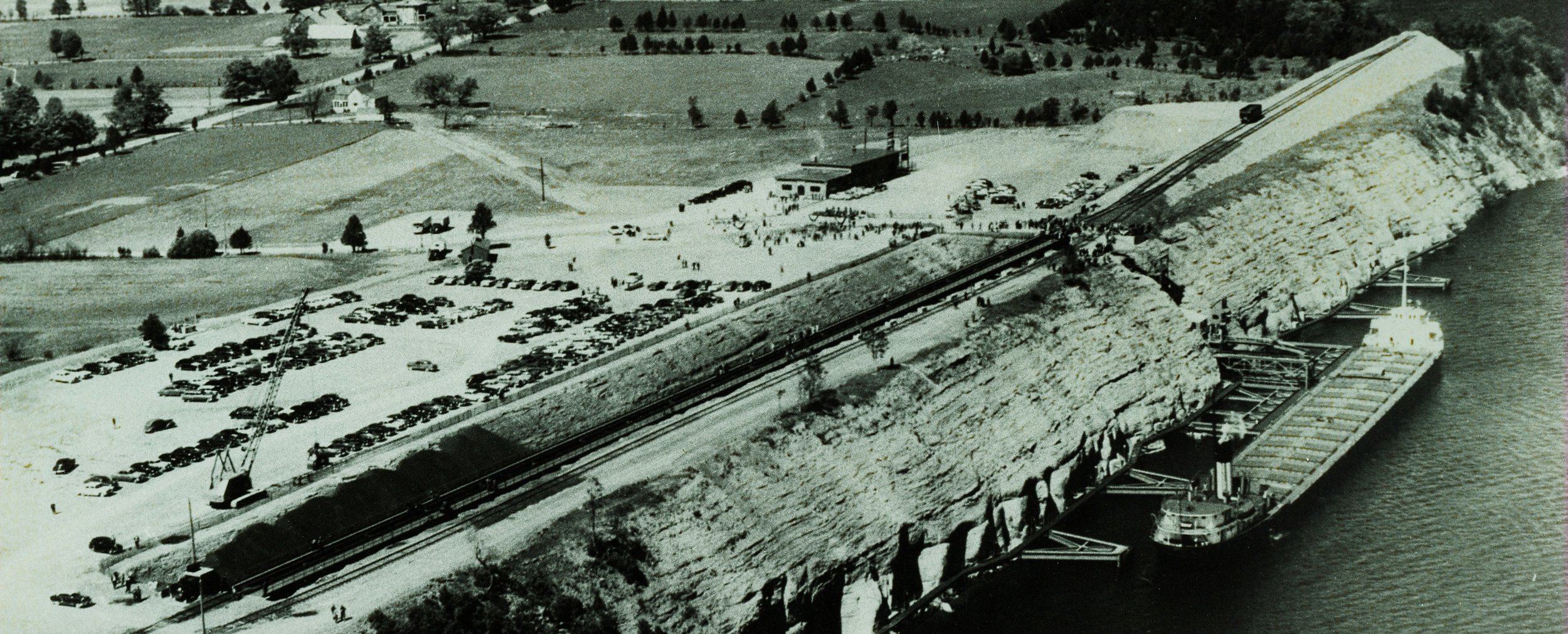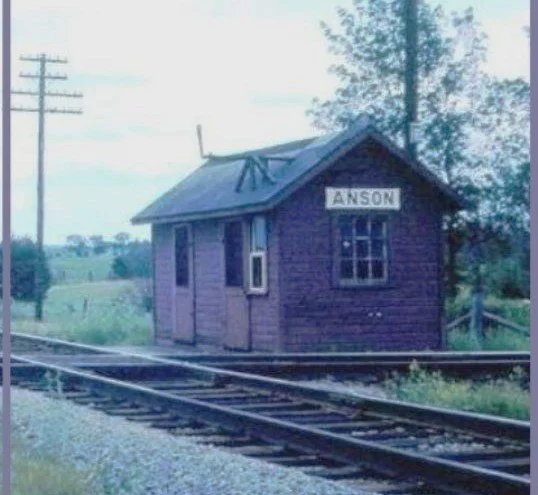THE HISTORY OF THE TELEPHONE IN MARMORA
Article by Gerald Belanger
As early as 1889, Marmora resident, Baldwin Chester Hubbell was requesting telephone exchange services from the North American Telegraph Company, which operated throughout the area. Accounts for 1894 indicated that it was possible to call Port Hope from Marmora for 35 cents.
It was 1900 when Mr. A. W. Carscallen, a banker, a shrewd businessman and a former MP for North Hastings, introduced the people of Marmora to its phone system. This was shortly after the North American Telephone Co. had a primitive and small switchboard installed in Mr. Carscallen's office, next to his private bank on McGill Street at Madoc Street. Subscribers could only talk with each other through the switchboard and there were only 23 telephones in service.
#1 - F.N. Marett Clothing, Grocery and House Furnishing Store
#3 - Connor & Jones Hardware Store, later Jones & Potts
#4 - Neal's Dairy
#6 - Lummis & Bonter Food Market, later H.A. Burwash Foodmarket, then Glover's Food Market
#7 - Marmora Dairy
#8 - Sanderson's Taxi and Trucking
#14 - Sanderson's Livery
#15 - Lavender's Hairdressing Parlorand also Lavender's Fuels
#16 - Shannon's Drug Store
1844-1907
#29 - Wm Sweet & Son Bakery
#30 - Marrin's Drug Store
#32 - Moloney & Forestell Chevrolet
#33 - G.B. Airhart
#35 - Father Murtagh/Sacred Heart Church
#36 - Marmora Heraldin 1907
#38 - Stetson's Jewellery
#40 - Frances Third's Beauty Salon
#43 - Reeve's Service Station
#47 - Sopha's Taxi
#49 - R.E. Lumsden Milling
These early subscribers were issued the standard Blake Telephone. It consisted of three boxes mounted one above the other on a board. The generator for ringing the switchboard or other subscribers on the line was on the top box, from which the receiver was hung. The mouthpiece was in the centre box and the battery or talking current was in the lower box. From early correspondence between Mr. Baldwin Chester Hubbell, who had come to Marmora in 1876, and the head office of the telephone company, it clearly indicates that Mr. Hubbell was requesting such a service as early as 1889. This was just 13 years after Alexander Graham Bell had invented the telephone. In fact, it was reported that a telephone was installed in Nelson McWilliams Livery as early as October, 1891.
By 1902, Carscallen and Co. had 25 telephone subscribers. Upon the death of Mr. Carscallen on February 12, 1907 at the age of 63, Mr. R.H. Simpson succeeded Mr. Carscallen as local manager. The Stave Mill, Mr. H.J. Clarke's Jewellery Store and Sweet's Bake Shop received telephones in 1908 and by 1912, Marmora had 50 telephone users.
Marmora Herald Nov. 1, 1906 “The Bell Telephone Company have installed about ten new long distance phones in the village, which are proving very satisfactory.”
Marmora Herald Jan.31, 1907 During the absence of Miss Clara Eastwood, Miss E. Chisholm filled her position at the telephone office.
When George MacQueen and Mr. J. Bowen moved from their offices to a room above McDonnell's Tailor Shop, the switchboard was moved to their old offices. Miss Draughan of Smith Falls was the switchboard operator at the time. She stayed on until she was transferred to the Madoc Telephone Office on May 3, 1909. Around this time, Miss Eastwood assumed duties at the local office. Miss Eastwood and her mother left Marmora for Seattle, Washington in February of 1916. She was immediately replaced by Elizabeth Maurice Foley and her sister Ana Loretto (Laura) Foley. After the death of Elizabeth on November 22nd, 1920, Laura became the local telephone manager until her retirement in 1955.
Marmora Village Council was presented with a letter from the Toronto City Council, dated November 3, 1909, urging them to cooperate and sign their petition. The Ontario Government wanted to take over the long distance telephone lines and for the small municipalities to take over and operate the rural lines. In 1912 the total telephone subscribers in Marmora had' climbed to 50. The population of Marmora Village in 1914 was 900.
Feeling isolated from the rest of the communities, the local rural areas formed and installed their own telephone systems. John William Bonter, an operator of a large lumber company in the Beaver Creek settlement, signed up 22 other shareholders in 1914 and together they installed poles for about ten miles in their area. Their company was called the "Northern Mutual Rural Telephone Co.". Likewise, the farming community east of the Village built and maintained their own company, ''The Lily Creek Telephone Co.", All these independent companies failed to exist after April 1963.
In 1910, Bell Telegraph Co. purchased the North American Telegraph Co. In the same year, copper telephone lines were installed from Marmora to Trenton where it connected with the long distance network of Bell Canada. Now telephone calls could be placed up to 1000 miles. Beyond that range it wasn't always possible to make a connection. However, by 1920, it was possible to call any point in Canada or the United States but only American lines if the calls were placed to phones outside of Ontario and Quebec.
By 1920 there were 86 telephones in Marmora on the local switchboard. In 1925 there were 100 residence and business phones and another 24 added by 1930. However, to prevent excessive rate changes imposed by Bell in 1921, several municipalities joined together to form the "Municipal Telephone System". This movement was intended to have a municipal telephone system spread throughout the northern part of Hastings County. The Marmora Herald, dated October 6, 1921, wrote:
'The Bell Telephone Co. has filed with Reeve Airhart a schedule of the proposed rate increases for exchange service. The average monthly increase is 45 cents or a total yearly increase of $5.40. The Marmora Council will protest the proposed increase to the Dominion Railway Board.'
Again, in 1926, the local telephone District Manager wrote an article in the Herald dated January 28, 1926:
"Only twice since the pre-war days have our rates been increased - 10 percent in 1918 and 12 percent in 1921. We believe our patrons will agree that the importance of maintaining the standard of service and extending it promptly to new applicants far out-weighs the modest increase which we are proposing for this exchange."
During 1928, Bell Telephone Co., started stringing a new line from Toronto to Montreal. By 1931, Canada was number one in telephone conversations per capita and fourth with a total of 1,364,000 telephones. During 1939, Bell work crews made extensive improvements to its lines in Marmora and vicinity. Old telephone poles were removed not only on the Bell Telephone system but also on the rural lines making way for the modern dial phones that would be installed that year.
In 1940 it was reported that for the eleventh consecutive year, Canadians were again number one in telephone conversation. In 1938 the average Canadian had placed 235 calls whereas in the United States it was 223. One year after the Second World War had ended, the Marmora switchboard had finally reached the 200 mark. By 1955 the switchboard had grown to 488 subscribers.
Overseas radio/telephone service was opened between New York and London in 1927 and this service gradually extended to other centres on both sides of the Atlantic. By 1932, the Trans Canada Telephone was established. This made calls possible to any point in Canada over our own Canadian lines.
The complete conversion to dial telephones in Marmora involved closing down the old telephone switching office and building a new exchange building on McGiII Street. The tender for the new building was awarded to Gray and Banks of Peterborough with the provision that it be completed by February 1962. The last switchboard manager at the old McGill office was Mrs. Doris Merkley who had come up from the Iroquois office in 1957 and completed her last shift on August 5, 1962. Other women on her staff included Miss Flossie Boyd, Miss Shirley Lummiss, Mrs. Francis Crawford, Mrs. Joan Lloyd, Mrs. Mary O'Brien, Mrs. Ida Provost and Vivian Johnston.
Witnessed by members of the Village and Township Councils and representatives from the Marmoraton Mining Co., Reeve Wiliam Arthur Shannon placed the first official long distance call on the new dial phone system at the Royal Hotel on Aug. 2, 1962. There were a few snags that had developed with the new dial system, as reported by the Village Council. Marmora had been assigned the exchange designation of 472 and 613 as the area code for long distance. The Marmora Fire Hall had initially received the number 472-2101 and cecil Neal's Dairy (Marmora's Fire Cheif) was assigned 472-2102. After the Firehall received several calls requesting milk delivery, their number was soon changed by council.
Pictured above - Switchboard operators Doris Merkley, Mrs. Francis Crawford, Miss Lummiss, Miss Woodhouse, Flossie Boyd
Three Foley girls worked as operators in Marmora. Maurice Foley and Sarah Shannon had four daughters - Mary, Laura, Theresa and Maurice Elizbeth. Laura Foley died at age 85, but the other three died of polio before the age of 24.
Carrion Curl wrote to say: “This is a picture of my grandmother Vivian Woodhouse Johnson. She is a sister to Ford Woodhouse,”

































